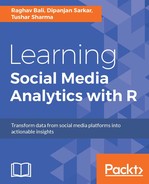The Internet has truly grown to be humongous, especially in the last decade, with the rise of various forms of social media that give users a platform to express themselves and also communicate and collaborate with each other. The current social media landscape is a complex mesh of social network platforms and applications, catering to specific audiences with unique as well as overlapping features. Each of these social networks are potential gold mines of data which are being (and can be) used to study, leverage and improve our understanding of demographics, behaviors, collaboration, user engagement, branding and so on across different domains and spheres of our lives.
This book will help the reader to understand the current social media landscape and help in understanding how analytics and machine learning can be leveraged to derive insights from social media data. It will enable readers to utilize R and its ecosystem to visualize and analyze data from different social networks. This book will also leverage machine learning, data science and other advanced concepts and techniques to solve real-world use cases spread across diverse social network domains including Twitter, Facebook, GitHub, FourSquare, StackExchange, Flickr, and more.
Chapter 1, Getting Started with R and Social Media Analytics, builds on foundations related to social media platforms and analyzing data relevant to social media. A concise introduction to R is given, including coverage of R syntax, data constructs, and functions. Basic concepts from machine learning, data analytics, and text analytics are also covered, setting the tone for the content in subsequent chapters.
Chapter 2, Twitter – What's Happening with 140 Characters, sets the theme for social media analytics with a focus on Twitter. It leverages R packages to extract and analyze Twitter data to uncover interesting insights through multiple use-cases, involving machine learning techniques such as trend analysis, sentiment analysis, clustering, and social graph analysis.
Chapter 3, Analyzing Social Networks and Brand Engagements with Facebook, focuses on analyzing data from perhaps the most popular social network in the world—Facebook! Readers will learn how to use the Graph API to retrieve data as well as use frameworks such as Netvizz to extract brand page data. Techniques to analyze personal social networks will be covered in detail. Besides this, readers will gain conceptual knowledge about social network analysis and graph theory. This knowledge will be used in action by analyzing a huge network of football brand pages to understand relationships, page engagement, and popularity.
Chapter 4, Foursquare – Are You Checked in Yet?, targets the popular social media channel Foursquare. Readers will learn how to collect this data using the Foursquare APIs. Steps for visualizing and analyzing this data will be depicted to uncover insights into user behavior. This data will be used to define and solve some analytics use-cases, which include sentiment analysis, graph analytics, and much more.
Chapter 5, Analyzing Software Collaboration Trends I – Social Coding with GitHub, introduces the popular social coding and collaboration platform GitHub for analyzing software collaboration trends. Readers will gain insights into using the GitHub API from R to extract useful data pertaining to users and repositories. Detailed analyzes of repository activity, repository trends, language trends, and user trends will be presented with real-world examples.
Chapter 6, Analyzing Software Collaboration Trends II – Answering Your Questions with StackExchange, introduces the StackExchange platform through its data organization and access methods. Readers learn and uncover interesting collaboration, demographic, and other patterns through use cases which leverage visualizations and different analysis techniques learned in previous chapters.
Chapter 7, Believe What You See – Flickr Data Analysis, presents Flickr through its APIs and uses some amazing packages such as piper, dplyr, and so on to extract data and insights from some complex data formats. The chapter also leverages machine learning concepts like clustering and classification to better understand Flickr.
Chapter 8, News – The Collective Social Media!, deals with analysis of free and unstructured text. Readers will learn how to collect news data from web sources using methodologies like scraping. The basic analysis on the textual data will consist of various statistical measures. Readers will also gain hands-on knowledge on advanced analysis like sentiment analysis, topic modeling, and text summarization on news data based on some interesting use cases.
